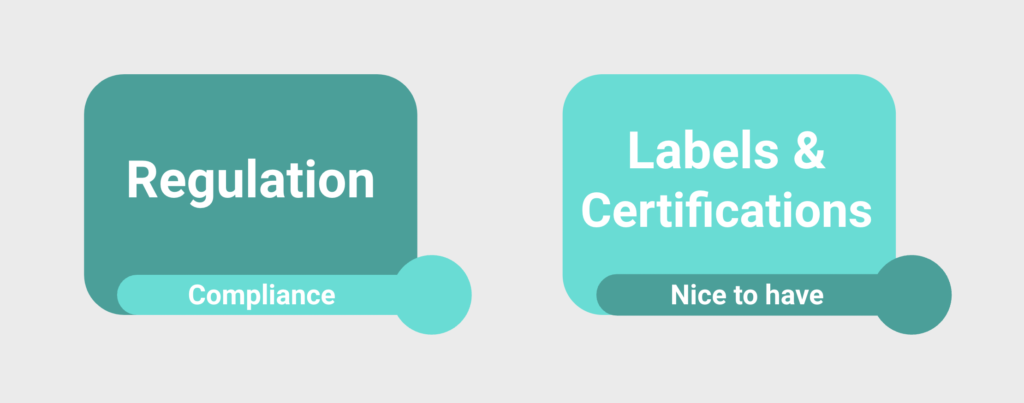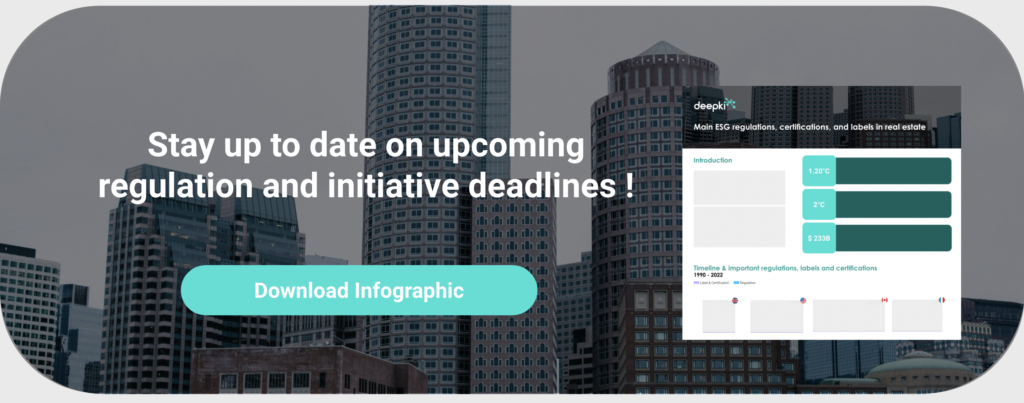Faced with the risks of climate change, the European Union has formulated bold objectives for reducing greenhouse gas emissions in the real estate sector. This article offers an overview of the measures on ESG (Environmental, Social, and Governance) issues taken by the European Union, and their equivalents implemented by different member states.
First, organizations have to comply with applicable mandatory ESG reporting requirements. Second, they can choose the most relevant voluntary ESG reporting framework depending on their market and competition and select the most recognized asset ESG scoring tool. Finally, organizations may also choose from a wide variety of voluntary labels and certifications. We’ll get to see how they differ from one another, but first, we need to make sure the definitions are clear. A certification is a procedure by which a third party gives written assurance that a product, process, or service is in conformity with certain standards. A certification label is a label or symbol indicating that compliance with standards has been verified. The use of the label is usually controlled by the standard-setting body.
Deepki presents and compares a non-exhaustive list of the best-known and most relevant ESG measures.

Regulations, certifications and labels at the European level
The EU keeps providing ESG regulations to achieve the 2030 and 2050 climate objectives. The goal of these regulations is to reach carbon neutrality across Europe by 2050 and prevent greenwashing and provide transparency to investors. The most famous examples are the Taxonomy Regulation and the SFDR.
Taxonomy Regulation
This regulation is the backbone of EU ESG regulation, as it provides a clear reference as to what activities should be considered green and under what conditions. Deepki experts are up to date on this complex regulation and can accompany you to keep up with the upcoming deadlines and processes. A new voluntary standard, called the European Green Bond Standard (EU GBS), is also aimed at increasing transparency and accountability. Issuers will have a tool to demonstrate that they are funding legitimate green projects aligned with the EU Taxonomy.
SFDR (Sustainable Finance Disclosure Regulation)
Under the SFDR rules, all asset managers and pension funds (whether or not they are focused on sustainability) must disclose how they consider ESG risks in their investment decisions. Funds will have to include information on their website as well as in their fund documentation and show investors where ESG risks lie in their portfolios. SFDR compliance starts with measuring the climate risk exposure and carbon impact of your assets, using the data at your disposal. By automating your data collection, Deepki Ready can assist you and accelerate the data recovery and centralization phases for information use. The final step: our experts help you trace a path toward asset performance that supports your own objectives while satisfying those of the SFDR.
Read more: SFDR regulation: improving the ESG traceability of your real estate assets
Energy Performance of Buildings Directive (EPBD)
The EPBD requires member states to lower the energy consumption of buildings and all new buildings from 2021 onwards (public buildings from 2019) to be nearly zero-energy buildings (NZEB). It provides the first definition of a nearly zero-energy building which is “a building with very high energy performance”. Very low or nearly zero energy requirements should be covered to a very significant extent by energy from renewable sources, including energy from renewable sources produced on-site or nearby”.
GRESB
The GRESB certification is one of the best ways to guarantee the preservation of your assets’ value by highlighting your extra-financial performance. It assesses and benchmarks the ESG performance of real estate investments internationally. It currently covers 117,000 assets across 64 countries. Certifications such as this one testify to your funds’ commitment to ESG standards, which now play a major role in the market’s assessment of an asset’s overall value.

Read more: Enhance your GRESB score with Deepki Ready
The CRREM is an Excel tool that assesses and benchmarks real estate assets, carbon emission pathways, and financial risk.
The GRI introduced the first set of standards helping organizations report their impact on the economy, the environment, and society. It targets organizations of any size, type, sector, or geographic location. Already, 93% of the world’s 250 largest companies use one of the GRI standards.
National initiatives across Europe
To reach these ambitious goals, each European country must arm itself with an adapted strategy. Environmental progress varies from one country to another, each member state determining its own regulatory path toward achieving the EU’s ambitious objectives.
ESG labels in Europe generally take an all-encompassing sustainability approach, however, thematic labels pushing the transition to a low-carbon economy and climate social issues are also making headway. Labels are mostly private sector-led but governments have also started promoting national labels, such as the national SRI label in France, LuxFLAG, and Germany’s FNG label, which has been adopted by other countries. As the number of labels increases, it is not always easy for property and asset managers to fully understand what is being offered, especially because labels do not adopt the same approach. Alongside the development of labels, a quantitative approach has emerged in recent years, with ESG ratings of buildings, similar to ratings on performance quality.
Labels, certifications, and ratings all aim to help investors choose responsible investment products. An important difference between labels and ratings is that the property manager takes the initiative to obtain a label, which is generally focused on a certification, whereas the rating organization unilaterally rates a building, irrespective of whether the manager asks for the rating. Unlike labels, ESG ratings do not certify a portfolio ESG integration process or investment inputs with a specific methodology. Rather, ESG ratings generally aim to “score” the portfolio on sustainability with a rating.
As far as labels, certifications, and ESG regulations go within the real estate sector, France, the Netherlands, and the United Kingdom are among those leading the way in Europe:
France
- Tertiary decree: the tertiary sector decree applies to tertiary activities of more than 1,000 m². It aims to encourage owners and users of assets to reduce their energy consumption, with a target of 40% reduction by 2030, 50% by 2040, and 60% by 2050. The first declarations must be made in December 2022. The process commits the owner and the tenant of the asset jointly and severally, and the sanctions are financial (€7,500 per building) and public, with a “Name & Shame”.
- HQE (High Environmental Quality) is a certification assessing the environmental, energy, health, and comfort aspects of buildings. 692,000 buildings are already certified in 27 countries (of which 620,000 are in France). It’s a voluntary certification allowing you to enhance the value of your assets based on non-financial criteria in order to increase their attractiveness.
- SRI: The Label ISR was created in 2016 by the French government to identify and promote sustainable and responsible investments.
French labels and regulations have a strict, rigorous, and time-consuming process. Deepki is here to gather all the necessary information in order to meet the expectations of these initiatives.
Read also: Tertiary Decree: best practices to coordinate with your tenants
United Kingdom
Since leaving the European Union on the 1st of January, 2021, the UK is no longer subject to EU regulations. While many pre-existing EU rules have been embedded into UK law and will remain unless changed or amended, new EU regulatory developments in the field of sustainability do not automatically apply.
- UK Sustainable Disclosure Regulation (SDR): The UK has based its climate reporting regime on the recommendations of the Task Force on Climate-Related Financial Disclosures (TCFD). However, SDRs go beyond this, both by requiring double materiality and by looking at other environmental impacts and risks on top of those arising from climate change.
- BREEAM (Building Research Establishment Environmental Assessment Method): BREEAM is the oldest certification of buildings on environmental criteria. It covers the whole life cycle of buildings, from planning to in-use and refurbishment. 590,000 buildings have been BREEAM-certified, in 87 countries worldwide (mostly in Europe). BREEAM can be completed, in particular with NF, HQE, and LEED certification. By combining these certifications, you can give credibility to the energy performance improvements in your buildings.
Read also: Retrofitting
Germany
- The Gebäudeenergiegesetz (GEG) (or Building Energy Law), came into force on 1 November 2020 and is the main legislative pillar for building efficiency in Germany. The law replaced the three previous acts, Energy Saving Act (EnEG), Energy Saving Ordinance (EnEV), and Renewable-Energies-Heat Act (EEWärmeG) to harmonize and update the legislation concerning energy in buildings in Germany. It introduces mandatory standards for energy-efficient building and refurbishment. It defines the requirements for a building’s energy efficiency and for the issue and use of the energy performance certificate. The EPBD is fully implemented and the regulation on the nearly zero-energy buildings (nZEB) is integrated into the unified law.
- Deutsche Gesellschaft für Nachhaltiges Bauen (DGNB): The DGNB is a German certification system for sustainable building. 5,000 projects are certified, in ca. 30 countries. This certification system offers a planning and optimization tool for evaluating sustainable buildings and urban districts.
Netherlands
- Bijna Energieneutrale Gebouwen (BENG – Almost Energy-Neutral Buildings): From the 1st of January, 2021, new buildings are now required to be carbon neutral and to use natural gas as much as possible.
Luxembourg
- LuxFLAG: Less known and widely spread, this label is a unique tool at the disposal of asset managers and other financial actors which they can use to highlight the ESG credentials of their investment products.
Other European countries are further behind, including Italy and Spain, where too many buildings still have an energy performance rating (DPE) of D or lower:
Spain
Building efficiency and decarbonization efforts in Spain are based on a package of strategies and documents, including the Climate Change and Energy Transition Law, which includes buildings sector provisions, as well as the Technical Building Code (CTE, Código Técnico de la Edificación) from 2019, which defines the current new building standards.
- Climate Change and Energy Transition Law: The law entered into force on May 20th, 2021 enforces the target of reaching climate neutrality by 2050 at the latest. It sets a goal to reduce greenhouse gas emissions by at least 23% by 2030 in comparison to 1990 emissions.
- The Technical Building Code came into force in 2007 and reunites the regulations of the construction of all types of buildings in Spain. While mainly focused on the basic safety in case of fire in buildings, the Code also establishes the demands for complying with the energy requirements in buildings.
Italy
In Italy, the most widespread initiatives are the ITACA protocol, LEED, and CasaClima.
- ITACA: Initiated by the Institute for innovation and transparency of procurement and environmental compatibility, the ITACA protocol is, at the national level, one of the most widespread tools for assessing the level of energy and environmental sustainability of buildings. As other rating systems verify the environmental performance of a building from different perspectives: human health, expenditure of energy, water, and other resources; ITACA also promotes the construction of increasingly innovative buildings and the use of sustainable materials produced with low energy consumption and guaranteed high levels of comfort. Since the first version of the protocol in 2014, it has been widely diffused across Italy as it’s a very versatile document with different purposes including, support planning for professionals, control and guidance for the public administration, the choice for the consumer, and investment enhancement for financial operators.
- CasaClima: The CasaClima standard was developed in 2002 with the objective to implement the European “Energy Performance of Buildings Directive” in the Autonomous Province of Bolzano – Alto Adige. It now represents an absolute reference in Italy in the field of energy-efficient and sustainable buildings. First and foremost, the CasaClima quality seal stands for improved comfort, healthy indoor conditions, and environmentally sustainable buildings. Assets designed according to the standards can save over90% in energy compared to traditionally built residences – thereby resulting in both CO2 reductions and financial savings.
Outside of Europe
While Europe is the worldwide leader in sustainable investing, home to almost half of global sustainable investment assets at the end of 2018, other initiatives outside this area are worth mentioning.
- LEED (Leadership in Energy and Environmental Design): proposed by the Canada Green Building Council (CaGBC), LEED is one of the world’s leading benchmarks for certification available for all building types and all building phases. Its objective is to enable the design, construction, management, and evaluation of high-performance buildings. Although it is very widespread in North America (100k+ certified buildings, with 75% of them in the US), it remains relatively unknown in France.
- NABERS (National Australian Built Environment Rating System): a performance-based national rating system that measures the environmental performance of existing buildings, tenancies, and homes in Australia. Australia and New Zealand make up the region with the world’s greatest proportion of responsible investment assets relative to total assets under management, with 63% of assets using a responsible investment approach.
- WELL: this Building Standard is a certification for all facility types, to assess health and wellbeing. It is not focused on the building, but rather on the well-being of those who live there, therefore, on the S of ESG.
Not quite there, yet
Although each country has its own standards for ESG labels and voluntary certifications, there are similarities between them. The goal is almost always the same: to provide a guarantee of ESG and sustainable quality of the labeled or certified assets.
As an asset manager and property manager today, it’s essential to stay up to date on different standards, to keep assets in compliance with all applicable regulations, and avoid any financial or market repercussions. The recognition of the labels and certifications on the market, due in particular to the anteriority and the internationalization of their standards, makes them clearly relevant tools. These initiatives have the potential to simplify discussions between asset managers and their clients – as they know what ESG topics are taken into account, provided that the criteria for labeling are clear.
However, while these labels and certifications can help certify a fund according to the categorization established by the different organizations, as their criteria are comparable and they potentially imply environmental and societal characteristics, they do not include any verification of the achievement of sustainable investment objectives – unlike EU regulations. For the time being, the vast majority of labels and certifications focus more on evaluating the asset’s performance than on measuring the results. Under the different regulatory waves, voluntary initiatives remain relevant as they are simpler and well-known. Choosing to include them in the strategy represents a respectable initiative that complements obligatory initiatives within the real estate sector.
Despite the slew of regulations that have emerged in recent years, the process of reducing GHG emissions is still too slow. In light of this, Deepki has created a number of tools and documents to help real estate actors in their environmental transition. To find out more, get in touch with our team of experts!



